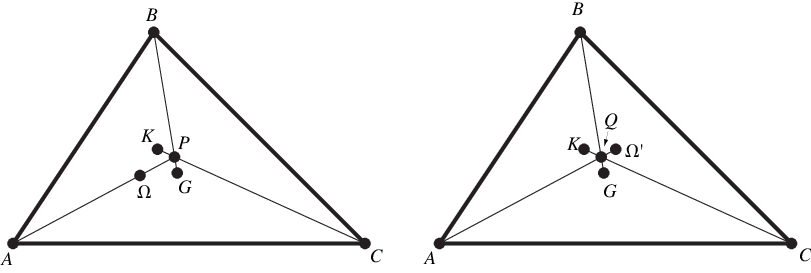The point of concurrence of the symmedians, sometimes
also called the Lemoine point (in England and France) or the Grebe point (in Germany).
Equivalently, the symmedian point is the isogonal
conjugate of the triangle centroid
. In other words, let
be the triangle centroid
of a triangle
,
,
, and
the medians of
,
,
, and
the angle bisectors of
angles
,
,
, and
,
, and
the reflections of
,
, and
about
,
, and
. Then
is the point of concurrence of the lines
,
, and
. According to Honsberger (1995, p. 53), the symmedian
point is "one of the crown jewels of modern geometry." The symmedian point
is Kimberling center
.
The symmedian point has equivalent triangle center functions and
|
(1)
|
(Honsberger 1995, p. 75), or
|
(2)
|
In exact trilinear coordinates, the symmedian point is the point for which is a minimum (Honsberger 1995, pp. 75-76).
A center
is the triangle centroid of its own pedal
triangle iff it is the symmedian point. The symmedian
point is the perspectivity center of a triangle and
its tangential triangle.
The following table summarizes the symmedian points for named triangles that are Kimberling centers.
| triangle | Kimberling | symmedian point of given triangle |
| anticomplementary triangle | symmedian point of the anticomplementary triangle | |
| circumcircle mid-arc triangle | midpoint of | |
| circum-medial triangle | trilinear quotient | |
| circumnormal triangle | circumcenter | |
| circumtangential triangle | circumcenter | |
| contact triangle | Gergonne point | |
| D-triangle | symmedian point | |
| excentral triangle | mittenpunkt | |
| first Morley triangle | first Morley center | |
| first Yff circles triangle | intersection of lines | |
| inner Napoleon triangle | triangle centroid | |
| medial triangle | complement of symmedian point | |
| orthic triangle | symmedian point of orthic triangle | |
| outer Napoleon triangle | triangle centroid | |
| reference triangle | symmedian point | |
| second Yff circles triangle | intersection of lines | |
| Stammler triangle | circumcenter | |
| tangential triangle | symmedian point of the tangential triangle | |
| second Brocard triangle | harmonic of |
In the above diagram with the symmedian point,
|
(3)
|
(Honsberger 1995, p. 76).
The symmedian point lies on the Brocard axis and the Fermat axis. It lies of the Brocard circle and is the center of the cosine circle. It also lies on the Jerabek hyperbola and the Thomson cubic.
Its distances from
to the sides of the triangle are
|
(4)
|
where
is the Brocard angle.
Distances to some other named triangle centers are given by
|
(5)
| |||
|
(6)
| |||
 |
(7)
| ||
|
(8)
| |||
 |
(9)
|
where
is the triangle centroid,
is the orthocenter,
is the incenter,
is the mittenpunkt, and
is the circumcenter.

One Brocard line, triangle median, and symmedian (out of the three of each)
are concurrent, with ,
, and
meeting at a point, where
is the first Brocard point
and
is the triangle centroid. Similarly,
,
, and
, where
is the second Brocard
point, meet at a point which is the isogonal
conjugate of the first (Johnson 1929, pp. 268-269).
The line joining the midpoint of any side to the midpoint of the altitude on that side passes through (left figure). In particular, the symmedian point of a right triangle is the midpoint
of the altitude to the hypotenuse
(right figure; Honsberger 1995, p. 59). The symmedian point
is the Steiner point of
the first Brocard triangle.
Given a triangle ,
construct the triangle
obtained as the intersection of the lines extended from each vertex though the symmedian
point
of
with the circumcircle of
. Then the symmedian point of
is again
(Honsberger 1995, p. 77).
The tangents to the circumcircle of a triangle at two of its vertices meet on the symmedian from the third vertex (Honsberger 1995, pp. 60-61). The Gergonne point of a triangle is the symmedian point of its contact triangle (Honsberger 1995, pp. 62-63). The symmedian point of a triangle is the triangle centroid of its pedal triangle. And finally, the lengths of the sides of the pedal triangle of the symmedian point are proportional to the lengths of the triangle medians of the original triangle (Honsberger 1995, p. 77).